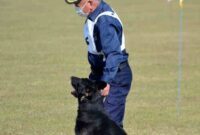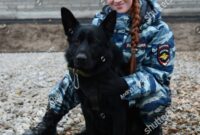Military Dog Careers – “Dogs of War” redirects here. For the Marvel Comics character, see War Dog (Marvel Comics). For other uses, see Dogs of War and Dogs of War.
A U.S. Air Force Belgian Malinois on an M2A3 Bradley Fighting Vehicle before departing for a mission in Kahn Bani Sahd, Iraq, February 13, 2007
Military Dog Careers

Dogs have a very long history in warfare dating back to ancient times. From combat training to their use as scouts, fighters, messengers, mercy dogs and trams, their uses were varied and some still exist in military use today.
Dogs In The Police Force & Military: Types & Roles
Among the Greeks and Romans, dogs mostly served as guard or patrol dogs, although they were sometimes taken into battle.
The earliest use of war dogs in combat documented in classical sources occurred around 600 BC. BC of Alyattes of Lydia against the Cimmerians. The Lydian dogs killed some intruders and routed others.
At the Battle of Pelusium (525 BC), Cambyses II used dogs, cats and other animals sacred to the Egyptians. By bringing these animals to the front, he allegedly succeeded in convincing the Egyptians to stop using their projectile weapons.
Gifts of war-breeding dogs to European kings were considered suitable barter throughout the Middle Ages. Other civilizations used armored dogs to repel caravans or attack enemies.
Dogs In Wwi
In the Far East in the 15th century, the Vietnamese emperor Lê Lợi raised a pack of over 100 dogs, led and trained by Nguyễn Xí.
Later, Frederick the Great of Prussia used dogs as messengers during the Seven Years’ War with Russia. Napoleon also used dogs in his campaigns. Until 1770, dogs were used to guard naval installations in France.
Geral Grant recounts how packs of southern bloodhounds were destroyed by Union troops wherever they were found because they had been trained to hunt runaway slaves before the war.

Dogs have been used in war by many civilizations. As the war progressed, their goals changed greatly.
United States Military Working Dog Service Medal Hi Res Stock Photography And Images
Dogs are used for many different purposes. Different breeds were used for different tasks, but always met the needs of the traders. Many roles for dogs in war are obsolete and no longer practiced, but the concept of the war dog is still alive and well in modern warfare.
In ancient times, dogs, often large mastiff-type dog breeds, were harnessed with armor or spiked collars and went into battle to attack the enemy. This strategy was used by various civilizations such as the Romans and Greeks. Although this is no longer as common as in earlier countries, modern militaries continue to use dogs as offensive weapons. US military SOCOM forces still use dogs in raids to capture escaping enemies or prisoners or to search areas too difficult or dangerous for human soldiers (eg crawlspaces).
Another attempt during World War II was proposed by a Swiss citizen living in Santa Fe, New Mexico. William A. Prestre suggested using large dogs to kill Japanese soldiers. He persuaded the military to lease a tire island in Mississippi to house training facilities. The army hoped to train up to two million dogs there. The idea was to begin the island invasion with landing craft releasing thousands of dogs against the Japanese defenders, followed by troops as the Japanese defenders scattered in confusion. One of the biggest problems was finding Japanese soldiers to train the dogs, as few Japanese soldiers were captured. Eventually, Japanese-American soldiers volunteered for training. Another big problem was the dogs; They were either too docile, did not respond properly to their beach crossing training, or were afraid of shell fire. After millions of dollars were spent without conclusive results, the program was abandoned.
The Soviet Union began using dogs to defend against tanks in the 1930s. Earlier anti-tank dogs were equipped with tilt-rod mines and trained to fight explosive tanks, which automatically detonated the mines. However, the dogs were trained with stationary Russian tanks and only very rarely ran under the moving tanks; Instead, they were shot as they ran alongside the moving tanks. While both Russian and German tanks were in the foreground, the dogs preferred to run towards the familiar Russian tanks.
Scott Medical & Healthcare College
Around the time World War I broke out, many European communities began using dogs to pull small carts for milk deliveries and similar purposes.
In August 1914, the Belgian army used dogs to pull its Maxim guns on wagons and transport supplies or, reportedly, even wounded people in their wagons.
Two dogs of the sturdy and docile Martin Belge breed were used to pull each machine gun or ammunition wagon. The dogs were already in common civilian use and were cheap to buy and feed. However, they proved to be more robust and more suitable for military use under fire than pack horses.

The dogs were officially withdrawn from military use in December 1916, although it took several months for horse-drawn vehicles and motor vehicles to fully replace them.
Titanium Fangs? The Technology Behind Navy Seal Dogs
At the beginning of the First World War, Frch had 250 dogs. The Dutch army copied the idea and had hundreds of dogs trained and operational by the end of World War I (the Netherlands remained neutral). The Soviet Red Army also used dogs to drag wounded people to aid stations during World War II.
Dogs were often used in battle to carry messages. They were released to muddy attention to another driver. This required a dog that was very loyal to two masters, otherwise the dog would not deliver the message on time or at all. Some service dogs also performed other communication tasks, such as pulling telephone lines or cables from one place to another.
A 2-kilogram (4-pound) Yorkshire terrier named Smoky was used to guide a telegraph cable through a 10 to 20 centimeter (4 to 8 in) and 21 meter (70 ft) long piece of pipe for secure communication without bringing troops into the firing line.
Dogs were often used as mascots for military units. The dog in question may be an officer’s dog, an animal the unit has adopted, or one of their dogs used in another capacity as a service dog. Some Navy Dogs, such as Sinbad and Judy, were themselves enlisted military personnel. Some units also chose to use a specific breed of dog as their default mascot, with new dogs replacing the old ones when they died or retired. The presence of a mascot was intended to boost morale and many were used for this purpose in the campaigns of the First World War. An example of this would be Sergeant Stubby for the US Army.
Afghanistan: Dogs Of War
Medical researchers and their allies in the armed forces awarded military medals to animals in laboratories to emphasize the military importance of animal experiments. Here, Army Surgeon General Norman T. Kirk, on behalf of the Freedom of Medical Research, presents medals to research dogs Trixie and Josie “for outstanding service to humanity.”
During World War II, dogs played a new role in medical experiments as they were the primary animals for medical research.
Animal testing allowed doctors to test new drugs without risking human life, although these practices came under greater scrutiny after the war. The US government responded by declaring these dogs heroes.
:strip_icc()/GettyImages-887464966-5c4ea39746e0fb00014a2cc0.jpg?strip=all)
The Cold War sparked a heated debate in the United States about the ethics of animal testing, particularly focusing on the treatment of dogs during World War II.
File:us Navy 030302 N 5362a 009 Military Working Dog, Camp Patriot, Kuwait.jpg
Many dogs were used to detect mines. They did not prove to be very effective in combat conditions. Sea mine detection dogs were trained by laying bare electrical cables below the surface of the earth.
The wires shocked the dogs and taught them that the danger lurked underground. Once the dog’s focus was correctly directed, dummy mines were placed and the dogs were trained to signal their presence. Although the dogs found the mines effective, the task was so stressful for the dogs that they could only work between 20 and 30 minutes at a time. The minesweepers were expecting unintended vibrations from the previously cool ground, which made them extremely nervous. The lifespan of the dogs was not long. Experiments with laboratory rats show that this experiment can be very extreme; In some tests, rats huddled in a corner until they starved to avoid being electrocuted.
Dogs have also been used in many cases in the past to detect fugitives and enemy troops, which is partly in line with the duties of a scout dog, but they use their scenting abilities to detect a Sct rather than to alert a handler on the first presentation of one St.
All scout dogs must be taught the difference between people and animals. Some dogs are trained to unobtrusively detect booby traps and hidden enemies such as snipers. Because of their sense of smell and hearing, dogs can recognize these dangers far better than humans. The best scout dogs are described as having somewhere between docile sniffer dogs and aggressive attack dogs.
Military Working Dogs Get Innovative Hearing Protection
Scout dogs are able to detect enemy threats within a radius of 1,000 meters. This scouting method is more effective compared to human scouting methods.
Scout dogs were used by the US in World War II, Korea and Vietnam to detect ambushes, weapons caches, etc.
- Search Rescue Dogs - July 29, 2024
- Police Dog Training - July 25, 2024
- Pointing Dog Training - July 25, 2024




